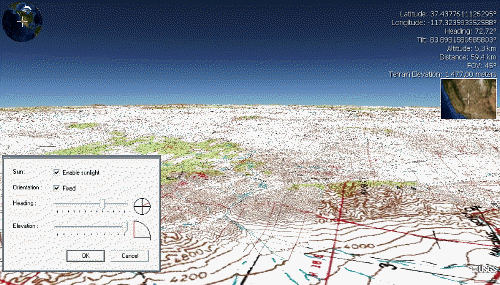|
Silpium Mons
Silpium Mons is a mountain on Jupiter's moon Io. It is 5.6 kilometers in height, 113 kilometers in length, and 79.7 kilometers in width. It covers an area of 7073 km2. It is a striated ridge, meaning it is an elevated structure dominated by one or more prominent linear or arcuate rises. It is named after a location in Greece where the mythological Io died of grief. Its name was adopted by the International Astronomical Union in 1979. It is located at , south of Svarog Patera, north of Mithra Patera, and northeast of Viracocha Patera. Its proximity to Svarog and Viracocha Paterae has been suggested to be evidence for a structural relationship between mountains and caldera A caldera ( ) is a large cauldron-like hollow that forms shortly after the emptying of a magma chamber in a volcano eruption. When large volumes of magma are erupted over a short time, structural support for the rock above the magma chamber is ...s on Io.Harland, David M. (2000). ''Jupiter Odyssey: ... [...More Info...] [...Related Items...] OR: [Wikipedia] [Google] [Baidu] |
Babbar Patera
Babbar Patera is a patera, or a complex crater with scalloped edges, on Jupiter's moon Io. It is about 86 kilometers in diameter and is located at . It is named after a Sumerian sun god, and its name was approved by the International Astronomical Union in 1979. Some scarps near Babbar Patera may represent faults. Immediately south of Babbar Patera is the plateau Lyrcea Planum, and further south is Svarog Patera. To the east is the mountain Egypt Mons Egypt Mons is a mountain on Jupiter's moon Io. It is 10 kilometers in height, making it the 11th tallest mountain on Io, and taller than Mount Everest. Although the U.S. Geological Survey gives a diameter of 193.7 kilometers, the Io Mountain Dat ....'' NASA World Wind'' 1.4. NASA Ames Research Center, 2007. References {{Io Surface features of Io (moon) ... [...More Info...] [...Related Items...] OR: [Wikipedia] [Google] [Baidu] |
Jupiter
Jupiter is the fifth planet from the Sun and the List of Solar System objects by size, largest in the Solar System. It is a gas giant with a mass more than two and a half times that of all the other planets in the Solar System combined, but slightly less than one-thousandth the mass of the Sun. Jupiter is the List of brightest natural objects in the sky, third brightest natural object in the Earth's night sky after the Moon and Venus, and it has been observed since Pre-history, prehistoric times. It was named after the Jupiter (mythology), Roman god Jupiter, the king of the gods. Jupiter is primarily composed of hydrogen, but helium constitutes one-quarter of its mass and one-tenth of its volume. It probably has a rocky core of heavier elements, but, like the other giant planets in the Solar System, it lacks a well-defined solid surface. The ongoing contraction of Jupiter's interior generates more heat than it receives from the Sun. Because of its rapid rotation, the planet' ... [...More Info...] [...Related Items...] OR: [Wikipedia] [Google] [Baidu] |
Io (moon)
Io (), or Jupiter I, is the innermost and third-largest of the four Galilean moons of the planet Jupiter. Slightly larger than Earth’s moon, Io is the fourth-largest moon in the Solar System, has the highest density of any moon, the strongest surface gravity of any moon, and the lowest amount of water (by atomic ratio) of any known astronomical object in the Solar System. It was discovered in 1610 by Galileo Galilei and was named after the mythological character Io, a priestess of Hera who became one of Zeus's lovers. With over 400 active volcanoes, Io is the most geologically active object in the Solar System. This extreme geologic activity is the result of tidal heating from friction generated within Io's interior as it is pulled between Jupiter and the other Galilean moons—Europa, Ganymede and Callisto. Several volcanoes produce plumes of sulfur and sulfur dioxide that climb as high as above the surface. Io's surface is also dotted with more than 100 mountains that ... [...More Info...] [...Related Items...] OR: [Wikipedia] [Google] [Baidu] |
Greece
Greece,, or , romanized: ', officially the Hellenic Republic, is a country in Southeast Europe. It is situated on the southern tip of the Balkans, and is located at the crossroads of Europe, Asia, and Africa. Greece shares land borders with Albania to the northwest, North Macedonia and Bulgaria to the north, and Turkey to the northeast. The Aegean Sea lies to the east of the Geography of Greece, mainland, the Ionian Sea to the west, and the Sea of Crete and the Mediterranean Sea to the south. Greece has the longest coastline on the Mediterranean Basin, featuring List of islands of Greece, thousands of islands. The country consists of nine Geographic regions of Greece, traditional geographic regions, and has a population of approximately 10.4 million. Athens is the nation's capital and List of cities and towns in Greece, largest city, followed by Thessaloniki and Patras. Greece is considered the cradle of Western culture, Western civilization, being the birthplace of Athenian ... [...More Info...] [...Related Items...] OR: [Wikipedia] [Google] [Baidu] |
Io (mythology)
Io (; grc, Ἰώ ) was, in Greek mythology, one of the mortal lovers of Zeus. An Argive princess, she was an ancestor of many kings and heroes, such as Perseus, Cadmus, Heracles, Minos, Lynceus, Cepheus, and Danaus. The astronomer Simon Marius named a moon of Jupiter after Io in 1614. Because her brother was Phoroneus, Io is also known as Phoronis (an adjective form of Phoroneus: "Phoronean"). She was sometimes compared to the egyptian goddess Isis, whereas her Egyptian husband Telegonus was "Osiris". Family In most versions of the legend, Io was the daughter of Inachus, though various other purported genealogies are also known. If her father was Inachus, then her mother would presumably have been Inachus' wife (and sister), the Oceanid nymph Melia, daughter of Oceanus. The 2nd century AD geographer Pausanias also suggests that she is the daughter of Inachus and retells the story of Zeus falling in love with Io, the legendary wrath of Hera, and the metamorphosis by whi ... [...More Info...] [...Related Items...] OR: [Wikipedia] [Google] [Baidu] |
International Astronomical Union
The International Astronomical Union (IAU; french: link=yes, Union astronomique internationale, UAI) is a nongovernmental organisation with the objective of advancing astronomy in all aspects, including promoting astronomical research, outreach, education, and development through global cooperation. It was founded in 1919 and is based in Paris, France. The IAU is composed of individual members, who include both professional astronomers and junior scientists, and national members, such as professional associations, national societies, or academic institutions. Individual members are organised into divisions, committees, and working groups centered on particular subdisciplines, subjects, or initiatives. As of 2018, the Union had over 13,700 individual members, spanning 90 countries, and 82 national members. Among the key activities of the IAU is serving as a forum for scientific conferences. It sponsors nine annual symposia and holds a triannual General Assembly that sets policy ... [...More Info...] [...Related Items...] OR: [Wikipedia] [Google] [Baidu] |
Svarog Patera
Svarog Patera is a patera, or a complex crater with scalloped edges, on Jupiter's moon Io. It is 124 kilometers in diameter and is located at . It is named after the Russian smith god Svarog. Its name was approved by the International Astronomical Union in 1979. Svarog Patera is a Voyager spacecraft-detected hot spot. North of Svarog Patera is Lyrcea Planum, north of which is Babbar Patera. To the south is Silpium Mons, and to the east is Hermes Mensa. To the southeast are Pyerun Patera and Epaphus Mensa.''NASA World Wind NASA WorldWind is an open-source (released under the NOSA license and the Apache 2.0 license) virtual globe. According to the website (https://worldwind.arc.nasa.gov/), "WorldWind is an open source virtual globe API. WorldWind allow ...'' 1.4. NASA Ames Research Center, 2007. References {{Io Surface features of Io (moon) ... [...More Info...] [...Related Items...] OR: [Wikipedia] [Google] [Baidu] |
Mithra Patera
Mithra Patera is a patera, or a complex crater with scalloped edges, on Jupiter's moon Io. It is about 34 kilometers in diameter and is located at . It is named after the Persian god of light, Mithra. Its name was adopted by the International Astronomical Union in 1985. To the north is Silpian Mons, and to the east is Pyerun Patera Pyerun Patera is a patera, or a complex crater with scalloped edges, on Jupiter's moon Io. It is about 57 kilometers in diameter and is located at . It is named after the Slavonic god of thunder, Pyerun. The name was adopted by the Internatio .... Located southwest is Viracocha Patera.'' NASA World Wind'' 1.4. NASA Ames Research Center, 2007. References {{authority control Surface features of Io (moon) ... [...More Info...] [...Related Items...] OR: [Wikipedia] [Google] [Baidu] |
Viracocha Patera
Viracocha Patera is a patera, or a complex crater with scalloped edges, on Jupiter's moon Io. It is about 61 kilometers in diameter and is located at . It is named after the Quechua creator god Viracocha. The name was adopted by the International Astronomical Union in 1979. Viracocha Patera is a Voyager spacecraft-detected hot spot. To Viracocha Patera's east-northeast is Mithra Patera, and to the northeast is the mountain Silpium Mons Silpium Mons is a mountain on Jupiter's moon Io. It is 5.6 kilometers in height, 113 kilometers in length, and 79.7 kilometers in width. It covers an area of 7073 km2. It is a striated ridge, meaning it is an elevated structure dominated by ....'' NASA World Wind'' 1.4. NASA Ames Research Center, 2007. References {{Io Surface features of Io (moon) ... [...More Info...] [...Related Items...] OR: [Wikipedia] [Google] [Baidu] |
NASA World Wind
NASA WorldWind is an open-source (released under the NOSA license and the Apache 2.0 license) virtual globe. According to the website (https://worldwind.arc.nasa.gov/), "WorldWind is an open source virtual globe API. WorldWind allows developers to quickly and easily create interactive visualizations of 3D globe, map and geographical information. Organizations around the world use WorldWind to monitor weather patterns, visualize cities and terrain, track vehicle movement, analyze geospatial data and educate humanity about the Earth." It was first developed by NASA in 2003 for use on personal computers and then further developed in concert with the open source community since 2004. As of 2017, a web-based version of WorldWind is available online. An Android version is also available. The original version relied on .NET Framework, which ran only on Microsoft Windows. The more recent Java version, WorldWind Java, is cross platform, a software development kit (SDK) a ... [...More Info...] [...Related Items...] OR: [Wikipedia] [Google] [Baidu] |
Caldera
A caldera ( ) is a large cauldron-like hollow that forms shortly after the emptying of a magma chamber in a volcano eruption. When large volumes of magma are erupted over a short time, structural support for the rock above the magma chamber is gone. The ground surface then collapses into the emptied or partially emptied magma chamber, leaving a large depression at the surface (from one to dozens of kilometers in diameter). Although sometimes described as a Volcanic crater, crater, the feature is actually a type of sinkhole, as it is formed through subsidence and collapse rather than an explosion or impact. Compared to the thousands of volcanic eruptions that occur each century, the formation of a caldera is a rare event, occurring only a few times per century. Only seven caldera-forming collapses are known to have occurred between 1911 and 2016. More recently, a caldera collapse occurred at Kīlauea, Hawaii in 2018. Etymology The term ''caldera'' comes from Spanish language, S ... [...More Info...] [...Related Items...] OR: [Wikipedia] [Google] [Baidu] |



